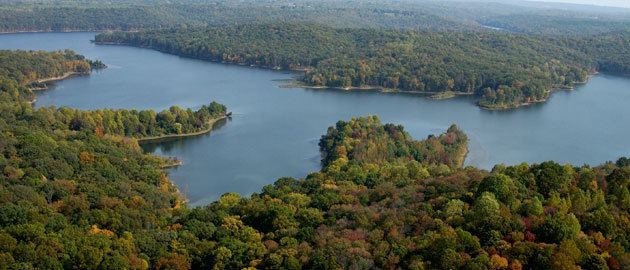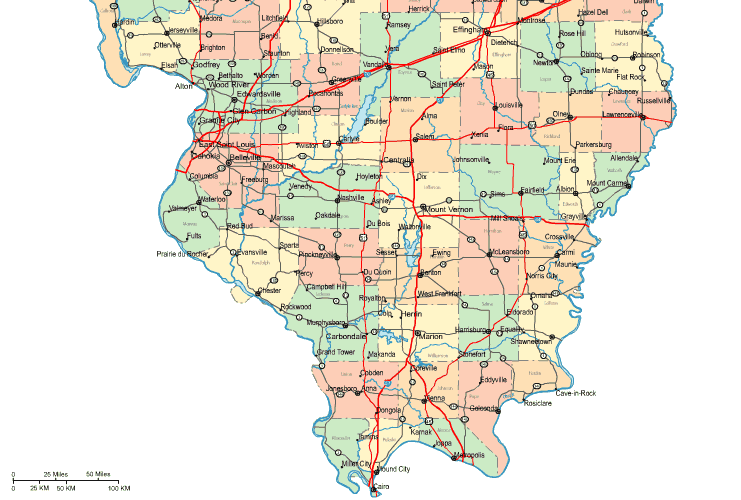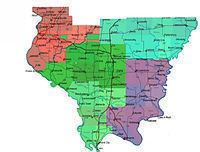Country United States Largest city Belleville | State Illinois Population 1.2 million | |
 | ||
Southern illinois s snake road april 1 2015
Southern Illinois (also known as "Little Egypt" or "Egypt") is the southern third of the state of Illinois. With the area code 618, the southern part of Illinois is geographically, culturally, and economically distinct from the rest of the state. It is considered a part of downstate Illinois. The region is bordered on three of four sides by the most voluminous rivers in the United States: the Wabash and Ohio rivers to the east and south, and the Mississippi River and its connecting Missouri River to the west.
Contents
- Southern illinois s snake road april 1 2015
- Accent tag southern illinois
- Early history
- Arrival of settlers
- 19th century turbulence
- Rise and fall during the 20th century
- Origin of Little Egypt name
- Northern boundary
- Metro East
- References

Southern Illinois' most populated city is currently Belleville at 44,478. Other principal cities include Alton, Centralia, Collinsville, Edwardsville, O'Fallon, Harrisburg, Mt. Vernon, Marion, and Carbondale, where the main campus of Southern Illinois University is located. Residents travel to amenities in St. Louis and Cape Girardeau, Missouri; Memphis, Tennessee; Evansville, Indiana; and Paducah, Kentucky. The region is also home to a major military installation, Scott Air Force Base.

The area has a population of 1.2 million people, who live mostly in rural towns and cities separated by extensive farmland and the Shawnee National Forest. The two most dense areas of population are Metro-East, which is the partly industrialized Illinois portion of the St. Louis Metropolitan Area and the Carbondale-Marion-Herrin, Illinois Combined Statistical Area, centered on Carbondale and Marion, a two-county area that is home to 123,272 residents.

The first settlers migrated from the Upland South, traveling by the Ohio River, and the region was affiliated with the southern agricultural economy and rural culture. Some settlers even owned slaves before the territory was organized and it was prohibited. Many areas developed an economy based on coal mining. Except for the counties in the St. Louis MSA, much of Southern Illinois is still culturally affiliated with the Mid-South: western Kentucky, southwestern Indiana, West Tennessee, and the Missouri Bootheel, and the people speak with similar accents. Southern Illinois, the earliest settled and once the wealthiest part of Illinois, is known for its rich history and the abundance of antebellum architecture remaining in its small towns and cities.

Southern Illinois is slowly gaining a cultural identity apart from its neighbors. Formerly dispersed rural populations have become more concentrated in the cities of Carbondale and Belleville.

Accent tag southern illinois
Early history
The earliest inhabitants of Illinois are thought to have arrived about 12,000 BC. They were hunter-gatherers, but also developed a primitive system of agriculture. After AD 1000, agricultural surpluses enabled them to develop complex, hierarchical societies. With the rise of the Mississippian culture in the Mississippi and Ohio River valleys, tribal leaders organized thousands to build complex urban areas with numerous large earthworks – pyramidal, ridgetop and conical mounds used for religious, political and ceremonial purposes. Cahokia, located in present-day Collinsville, Illinois, was the major regional center of this culture. It contains the largest prehistoric earthworks in the Americas, and has been designated a UNESCO World Heritage Site. The mound builders' culture seems to have collapsed between AD 1400–1500. The Mississippians had abandoned Cahokia long before the first European explorers arrived.
The Illinois Indian tribes, for whom the state is named, and other tribes migrated to Southern Illinois around AD 1500. Archeologists say they were not descendants of the earlier inhabitants. The Illini left numerous artifacts, including burial sites, burned-out campfires along the bases of bluffs, pottery, flint implements, and weapons. Structures built by them include stone forts or "pounds". Visitors can see a stone fort in Giant City State Park near Makanda. At least eight other such structures are known in the region.
In about 1673, French explorers from Quebec became the first Europeans to reach Illinois. The French named the area Illinois after the Indians who had welcomed them. The French explored the Mississippi River, establishing outposts and seeking a route to the Pacific Ocean and the Far East. As increasing Indian unrest and warfare began in Northern Illinois over the lucrative fur trade along the Great Lakes, the French concentrated on building outposts in Southern Illinois. The earliest European settlers were concentrated along the Mississippi, Ohio, and Wabash rivers, which provided easy routes for travel and trade. The settlements became important way stations and supply depots between Canada and the French ports on the lower Mississippi River. Other important early outposts in Southern Illinois were at Old Shawneetown and Fort Massac on the Ohio River.
After defeating the French in the French and Indian War (Seven Years' War) and signing the Treaty of Paris in 1763, the English ruled the Lower Great Lakes region. Their rule of this area was short lived. At the time, many French settlers moved from towns on the eastern side of the Mississippi to the western side, which was ruled by Spain after the war. It took over all the Louisiana Territory west of the river.
Arrival of settlers
European-American settlers were initially slow to arrive in Illinois after the United States victory in the American Revolutionary War. By 1800, fewer than 2,000 European Americans lived in Illinois. Soon more settlers came from the backwoods areas of Kentucky, Tennessee, Virginia, Georgia, and the Carolinas. These early settlers were mostly of English, German, and Scots-Irish descent.
In 1787, the federal government included Illinois in the Northwest Territory, an unorganized area that included present-day Ohio, Indiana, Michigan, and Wisconsin. Slavery was prohibited in this area, but for some time, slaveholders already in the area were allowed to keep their chattel property. As the areas became more populated with European Americans, they could be admitted as states to the Union. Illinois became a part of the Indiana Territory in 1800. Illinois settlers wanted more control over their own affairs and Illinois became a separate territory in 1809. It was admitted as a free state in 1818. In late 1811 and early 1812, the New Madrid earthquakes struck the region as one of the largest successions of earthquakes, including the most intensive ever indirectly inferred (not recorded) in the contiguous United States.
The first bank to be chartered in Illinois was located at Old Shawneetown in 1816. The first building used solely to house a bank in Illinois was built in 1840 in Old Shawneetown and was used until the 1920s. The Old Shawneetown State Bank has been restored as an historical site. Crops of cotton and tobacco were grown in the extreme southern region of Illinois. Cotton was grown mostly for the home weaver, but during the Civil War, cotton was also grown for export, as the regular supply of cotton from the South was not available. Enough tobacco was grown to make it a profitable crop for export. Both crops have been succeeded by other agricultural commodities.
19th century turbulence
A feud between families in Williamson County, called the Bloody Vendetta, lasted nearly ten years and took many lives. In all, 495 assaults with a deadly weapon were committed and 285 murders took place in Williamson County between 1839 and 1876. This was very unusual, as crime was almost non-existent in Illinois during its frontier years prior to this period of lawlessness.
In 1858, Abraham Lincoln ran for the U.S. Senate against Stephen A. Douglas. A debate was held in seven towns in Illinois, one being near Jonesboro. Many of the people living in Southern Illinois were first or second-generation Southerners. Cairo, Illinois, at the southern tip where the Ohio River joins the Mississippi, was of strategic importance. On either side of the rivers were states which, despite remaining in the Union, had numerous residents who were sympathetic to the South. Some leaders in this area had been active in the Knights of the Golden Circle, which proposed a southern pan-Caribbean confederation based on slave states and nations.
The outbreak of the American Civil War drew from the mixed loyalties in this region, and some residents enlisted in the Confederate Army. In June 1861, 34 men from the Southern Illinois counties of Williamson and Jackson traveled to western Tennessee and became part of Company G of the 15th Tennessee Volunteer Infantry, according to "Illinois Rebels – A Civil War Unit History of G Company, 15th Tennessee Regiment Volunteer Infantry" by Ed Gleeson (1996, Guild Press of Indiana, 435 Gradle Drive, Carmel, Indiana 46032). The Union Army also used Cairo as a staging area for its expeditions into the border states of Missouri and Kentucky, and also the Confederate states of Tennessee and Mississippi.
Rise and fall during the 20th century
Coal mining became an important industry in Southern Illinois around the start of the 20th century, with cities such as Harrisburg prospering, having a population of 16,000 people during the 1920s. Union miners all over the nation went on strike in 1922; during this period, 20 men were killed during a riot in Herrin, in Williamson County. It was called the Herrin Massacre, and the county was known as Bloody Williamson for years to come.
The Shelton Brothers Gang and Charles Birger gangs operated in Southern Illinois in the 1920s during Prohibition. Shoot-outs between these and other rival gangsters and with law enforcement officers were common. After being convicted of ordering the murder of the mayor of West City, the leader of the Birger gang, Charlie Birger, was hanged in 1928. In 1925 the Tri-State Tornado was the deadliest on record, devastating the city of Murphysboro and killing 234 people, the most in a single city in U.S. history.
The Wall Street Crash of 1929 and the Great Depression of the 1930s caused coal miners to lose their jobs as most mines closed. Farmers could not sell their crops and lost their land; families defaulted on home mortgage loans; and young people from the region began leaving for the cities to find work. After World War II, employment started to rise within the region, but unemployment continued to be a problem for the rural region for decades afterward. When the Clean Air Act of 1990 required many utility companies in the United States to switch to low-sulfur coal for the health of the nation, lacking affordable technology to clean the coal, the Southern Illinois region lost markets and the economy suffered. Agriculture has since become the main economic driver for the Southern Illinois region.
Southern Illinois is slowly gaining a cultural identity apart from its neighbors, as previously-dispersed rural populations become more concentrated around the cities of Marion and Belleville. Marion has grown tremendously since 1970 and in the process has been selected for Illinois' first STAR Bonds District for the Millennium Development, a project originally designed for a city ten times its size.
Population among the smaller cities and towns have dropped significantly as people moved to the Carbondale-Herrin-Marion combined statistical area and Metro East.
Origin of "Little Egypt" name
The nickname "Egypt" may have arisen in the 1830s, when poor harvests in the north of the state drove people to Southern Illinois to buy grain. Others say it was because the land of the great Mississippi and Ohio River valleys were like that of Egypt's Nile delta. According to Hubbs, the nickname may date back to 1818, when a huge tract of land was purchased at the confluence of the rivers and its developers named it Cairo /ˈkɛəroʊ/. Today, the town of Cairo still stands on the peninsula where the Ohio River joins the Mississippi.
Other settlements in the area were also given names with Egyptian, Greek or Middle Eastern origins: The Southern Illinois University Salukis sports teams and towns such as Metropolis, Thebes, Dongola, Palestine, Lebanon, New Athens /nuː ˈeɪθənz/, Sparta, and Karnak show the influence of classical culture. (Greek names were also related to the contemporary national pride in the new republic of the early 19th century, and were given to towns throughout the Midwest.) Egyptian names were concentrated in towns of Little Egypt but also appeared in towns further south. For instance, about 100 miles (200 km) south of Cairo, along the Mississippi, lies Memphis, Tennessee, named after the Egyptian city on the Nile.
Although Illinois was a free state prior to the American Civil War, some residents in Little Egypt still owned slaves. Illinois law generally forbade bringing slaves into Illinois, but a special exemption was given to the salt works near Equality. In addition, an exception was made for slaveholders who held long-term indentured servants or descendants of slaves in the area before it achieved statehood.
The nicknames for this region also arose from the political tensions prior to and during the American Civil War, as regions of the state allied differently with North and South. Because southern Illinois was settled by southerners, they maintained a sympathy for many issues of their former states. They supported the continuation of slavery and voted for Democrats at a time when the northern part of the state supported Republicans. The meaning is expressed in this description of the 1858 campaign of Douglas and Abraham Lincoln:
"In 1858, debating in northern Illinois, Douglas had threatened Lincoln by asserting that he would 'trot him down to Egypt' and there challenge him to repeat his antislavery views before a hostile crowd. The audience understood Douglas: overwhelming proslavery sentiment and Democratic unanimity in Egypt had led to the nickname."
In the fall of 1861, Democrats took a majority of seats in the state legislature. They worked to pass provisions of a new constitution, an initiative begun in 1860. They proposed reapportionment so the southern region's less populous counties would have representation equal to those in the north, which was growing more rapidly. Northern Illinois residents worried about the state coming under the political will of the southern minority. "Shall the manufacturing, agricultural and commercial interests of northern Illinois be put into Egyptian bondage?" wondered the Aurora Beacon." When Lincoln commissioned the Southern Illinois Democrat, John Alexander McClernand, as a brigadier general, he told him to "keep Egypt right side up".
In addition, southern Illinois had become the center of the Knights of the Golden Circle, a secret group devoted to supporting the Confederacy. With concern rising about armed southern sympathizers, in August 1862, U.S. Marshal David Phillips arrested several Democrats who allegedly belonged to the Knights, including men in respectable positions: Congressmen, state representatives, and judges. One was Circuit Judge Andrew Duff. They were sent to Washington, DC, where they were held for 68 days before release, but they were never charged. Democrats won across the state in the fall election.
After the war, other reasons were proposed for the nickname. Political divisions continued in the state. In the later 19th century, the central and southern agricultural areas joined the Populist Movement. Chicago and the industrial North aligned with similar areas and continued as predominantly Republican into the 20th century.
In 1871 Judge Andrew Duff wrote an article in which he ignored the war years and preceding political divisions. He claimed the name of Egypt related to Southern Illinois' role in supplying grain to northern and central Illinois following the "Winter of the Deep Snow" in 1830–31. Following a long winter and late spring, Upper Illinois lost much of its harvest in an early September frost. Southern Illinois's weather gave it good crops, so it could ship grain and corn north. The nickname supposedly arose from similarities of the events to the well-known Bible story of Jacob's sons going to Egypt for grain to survive a famine.
Belly dancer Farida Mazar Spyropoulos' appearance as "Little Egypt" at the 1893 World's Columbian Exposition in Chicago brought notoriety to the name, but she had no connection to the Illinois region. Other dancers took up the stage which popularized it further in the early 20th Century.
One of the earliest uses of the phrase "Little Egypt" is found in the Troy Weekly Call of Troy, Illinois, in 1912. A state news brief was headlined, "Two New Little Egypt Pastors." about two new Presbyterian pastors about to be installed at Brookport and Salem, Illinois. The Chicago Tribune appears to have first used the phrase "Little Egypt" in reference to Southern Illinois on 25 April 1920 in an article about fruit grown in the region. The title character in the comic strip "Moon Mullins" had a girlfriend named Little Egypt. The strip's creator Frank Willard, was a native of Anna and Southern Illinois.
Northern boundary
"Southern Illinois" is not a formal geographic designation and definitions of what constitutes Southern Illinois vary. Many Southern Illinois residents consider an area between Interstate 70 and Interstate 64 as the dividing line between the Central and Southern parts of the state. The geography of Illinois becomes gradually hillier as one travels farther South. One can see this driving south along Interstate 57. The Mattoon/Charleston area is fairly flat. Terrain becomes noticeably less flat as one gets to Effingham, but it is still level enough to support the vast corn and soybean fields that are so common in the rest of Central Illinois. South of Effingham on the interstate, one sees more trees and terrain that is too hilly for most large farms.
Metro East
The most populous region of Southern Illinois is the Illinois side of the St. Louis Metropolitan Statistical Area. Noted areas are Cahokia Mounds, the American Bottom, and East St. Louis, which has had a turbulent history related to industrialization and labor, immigration and the struggle for equal rights.
